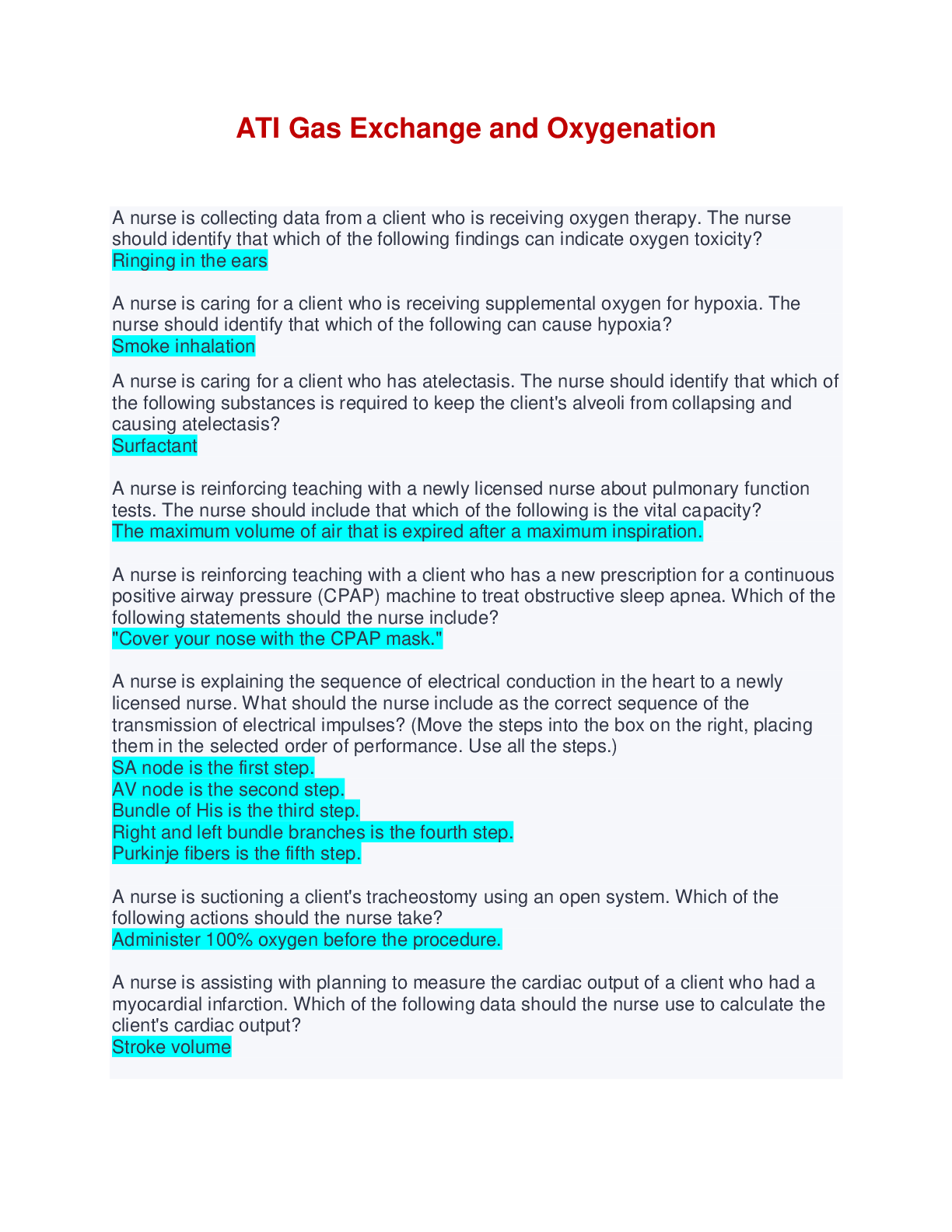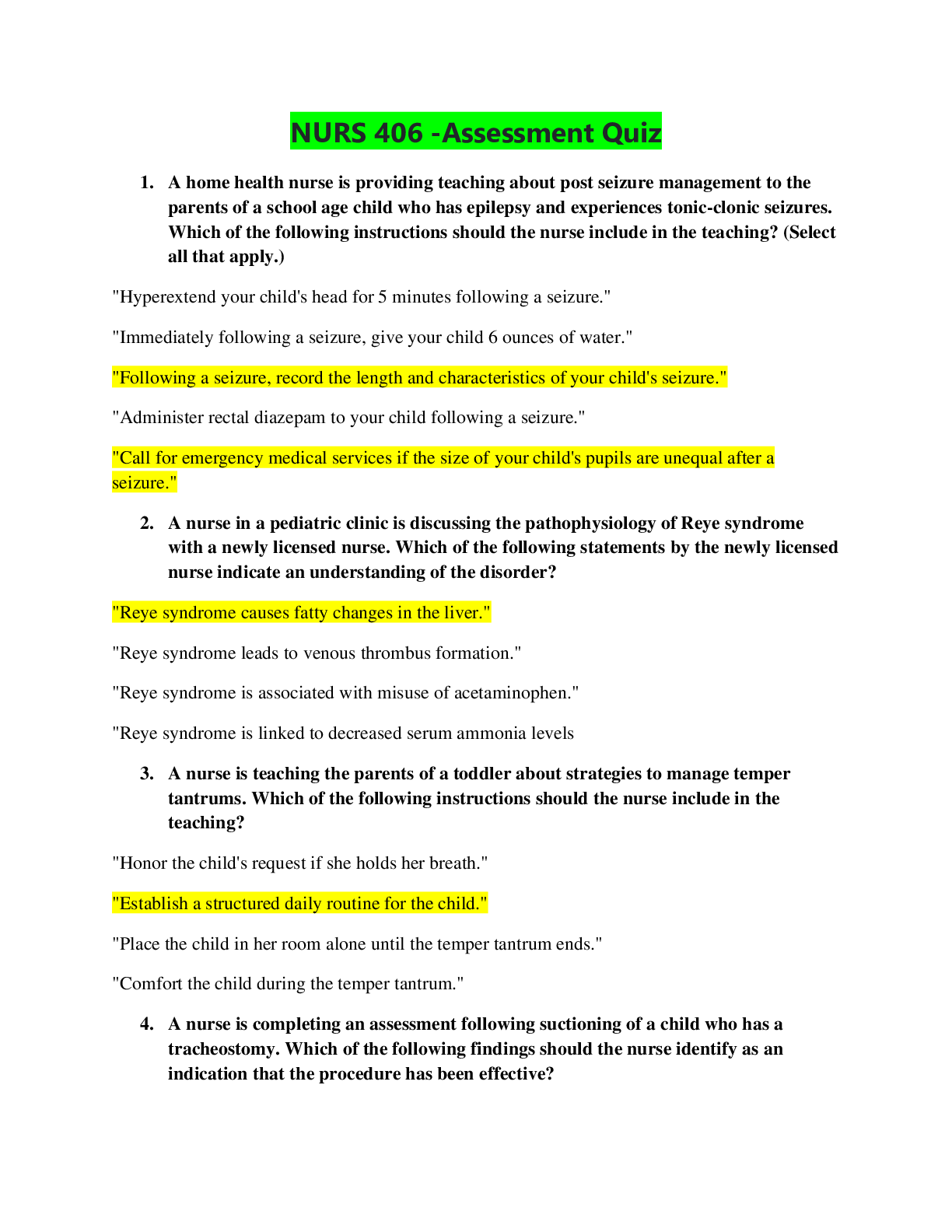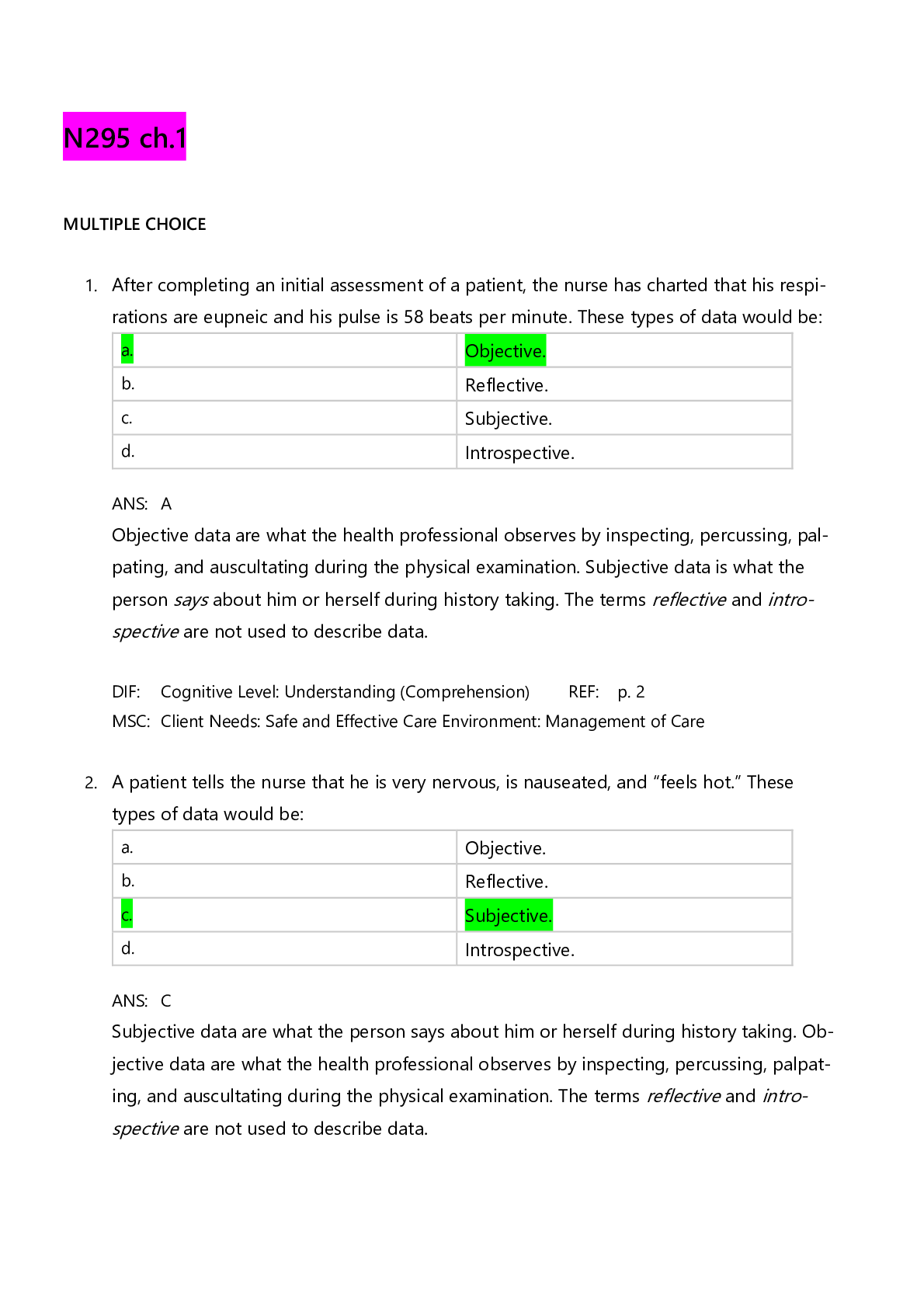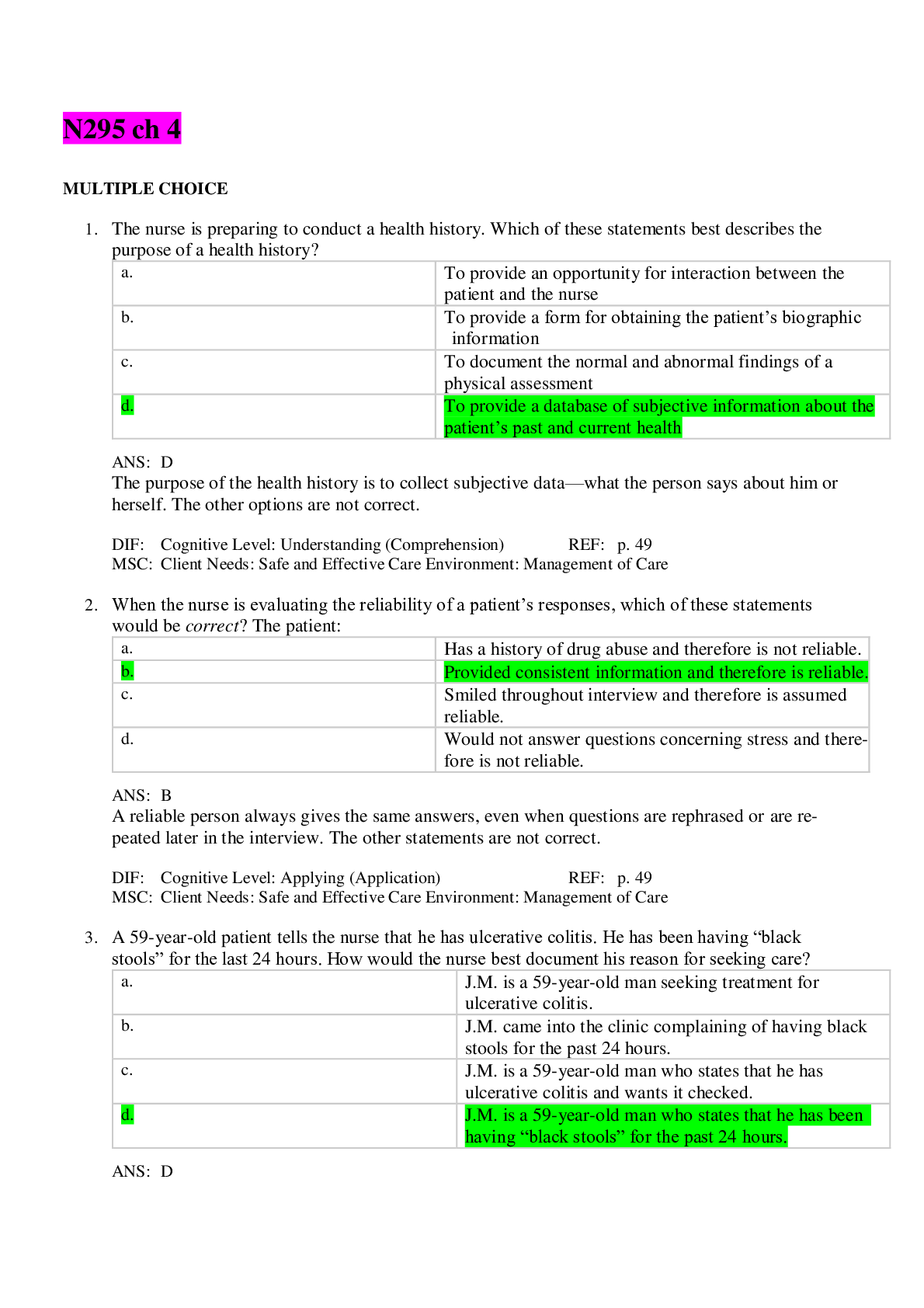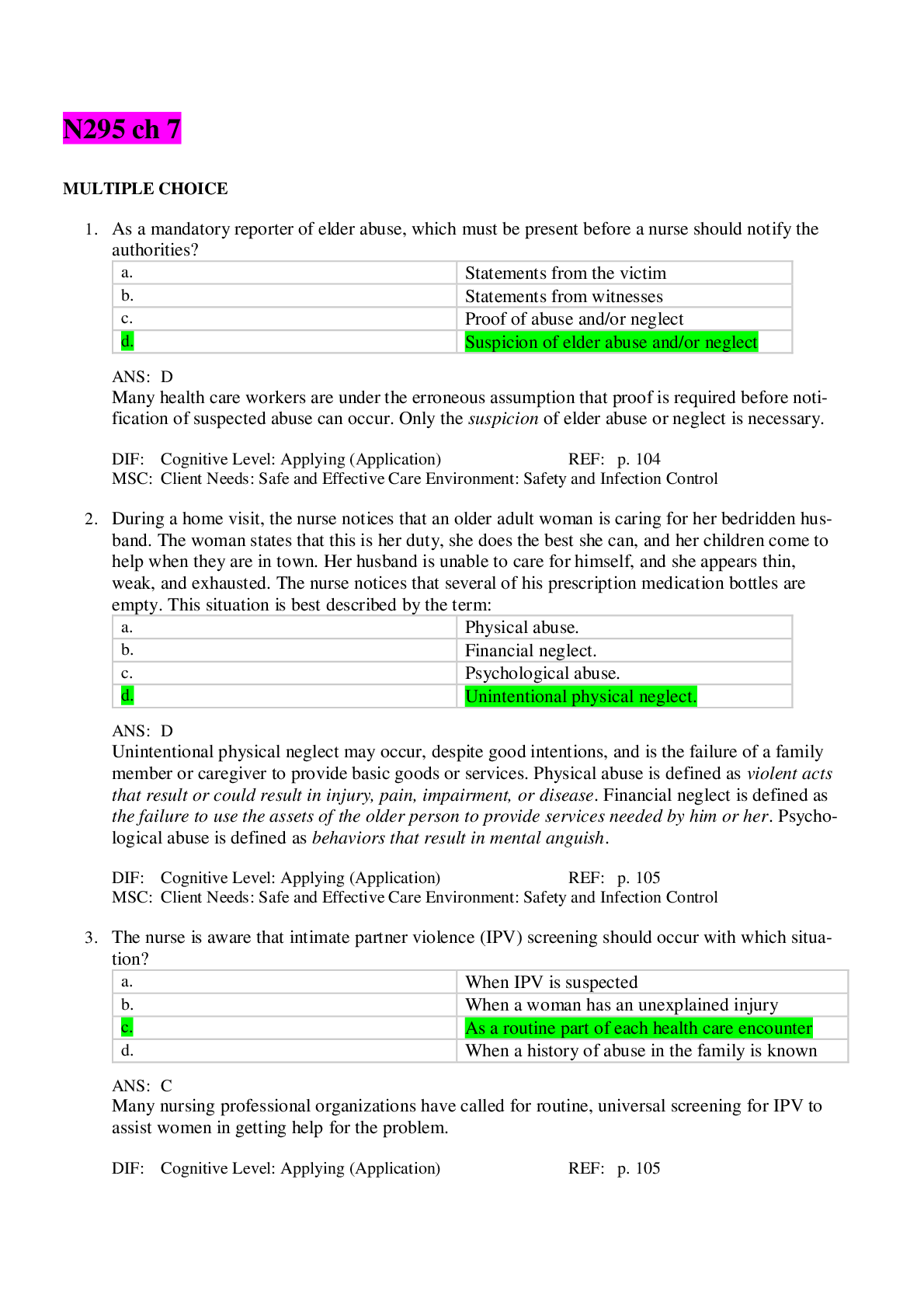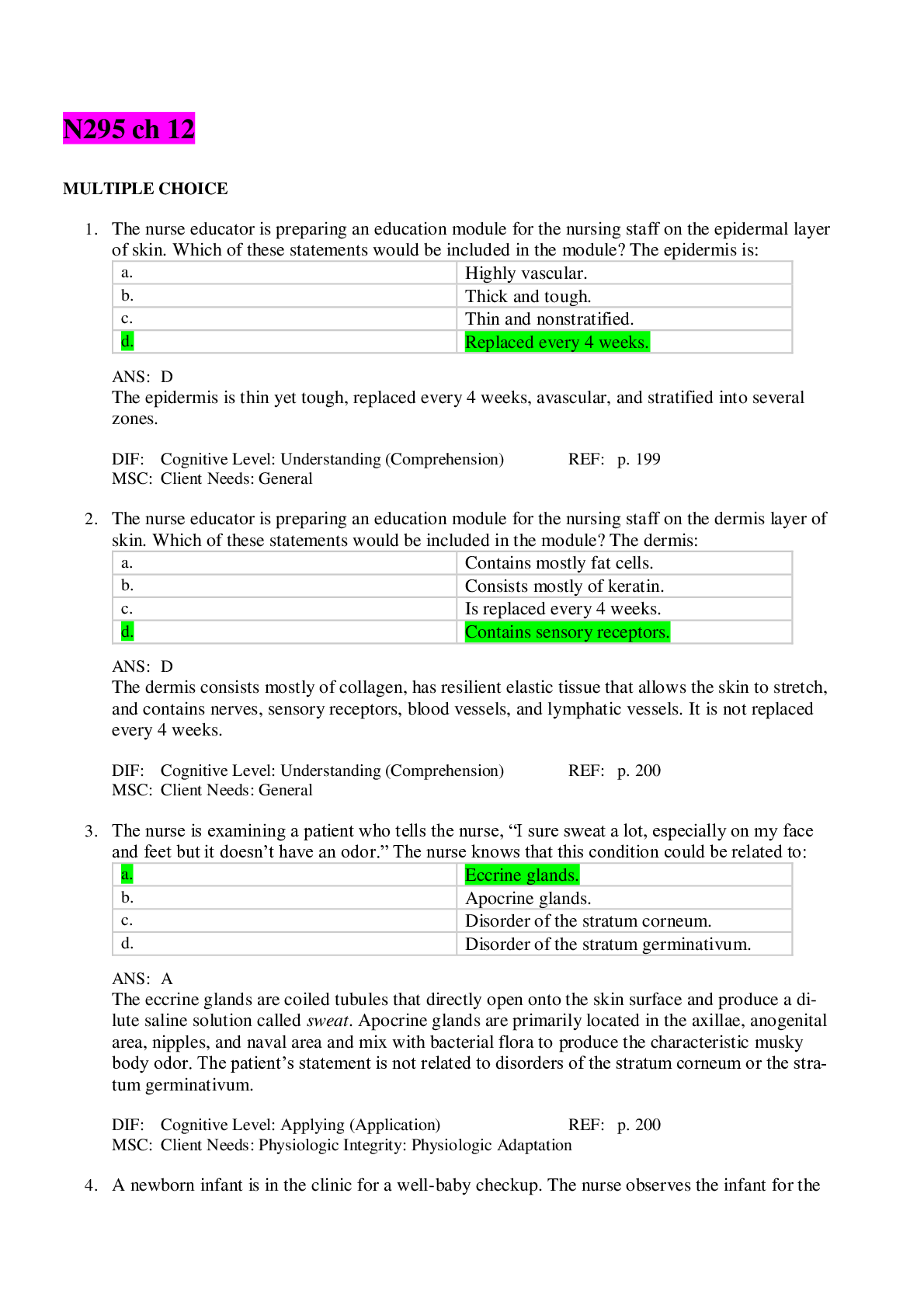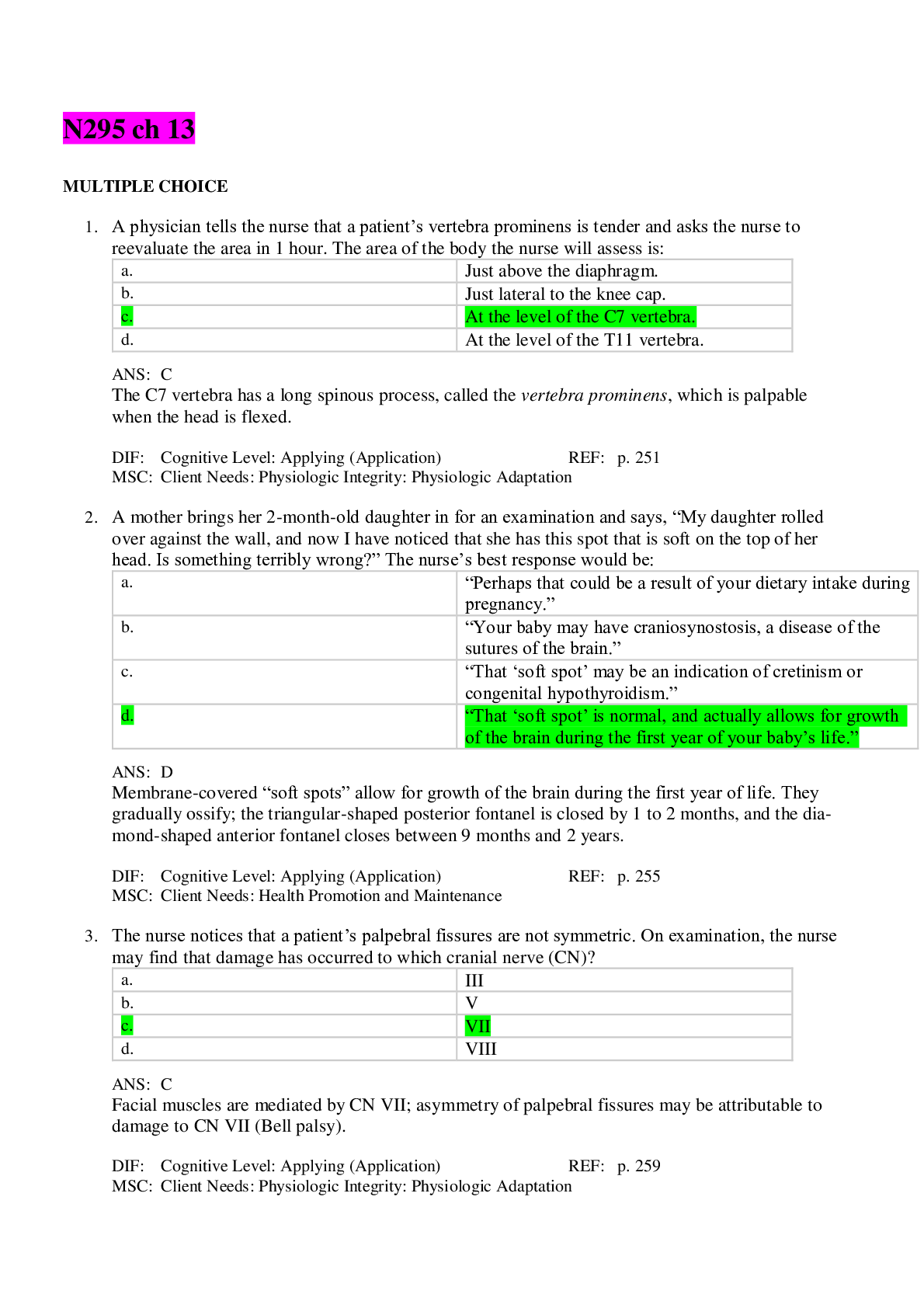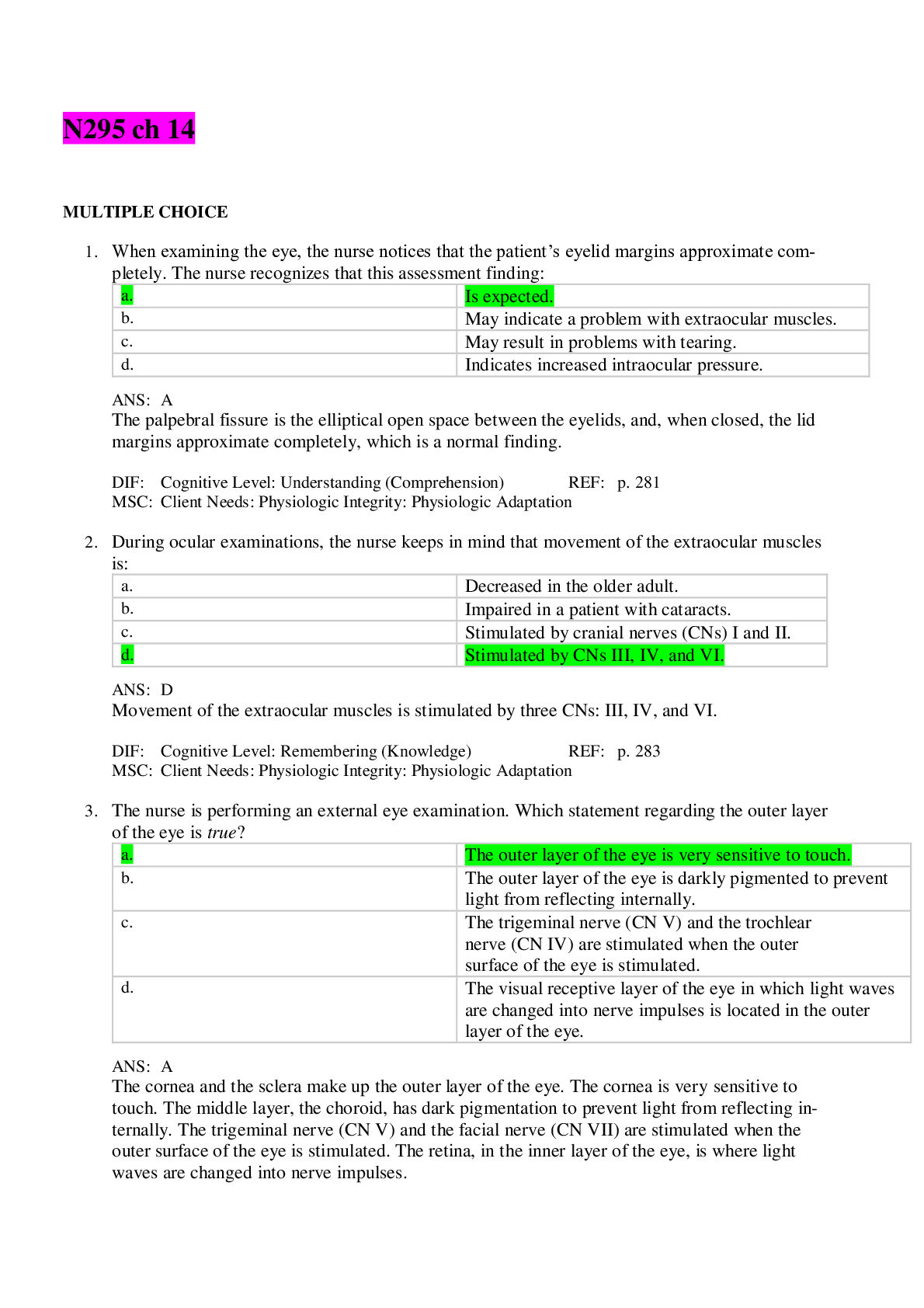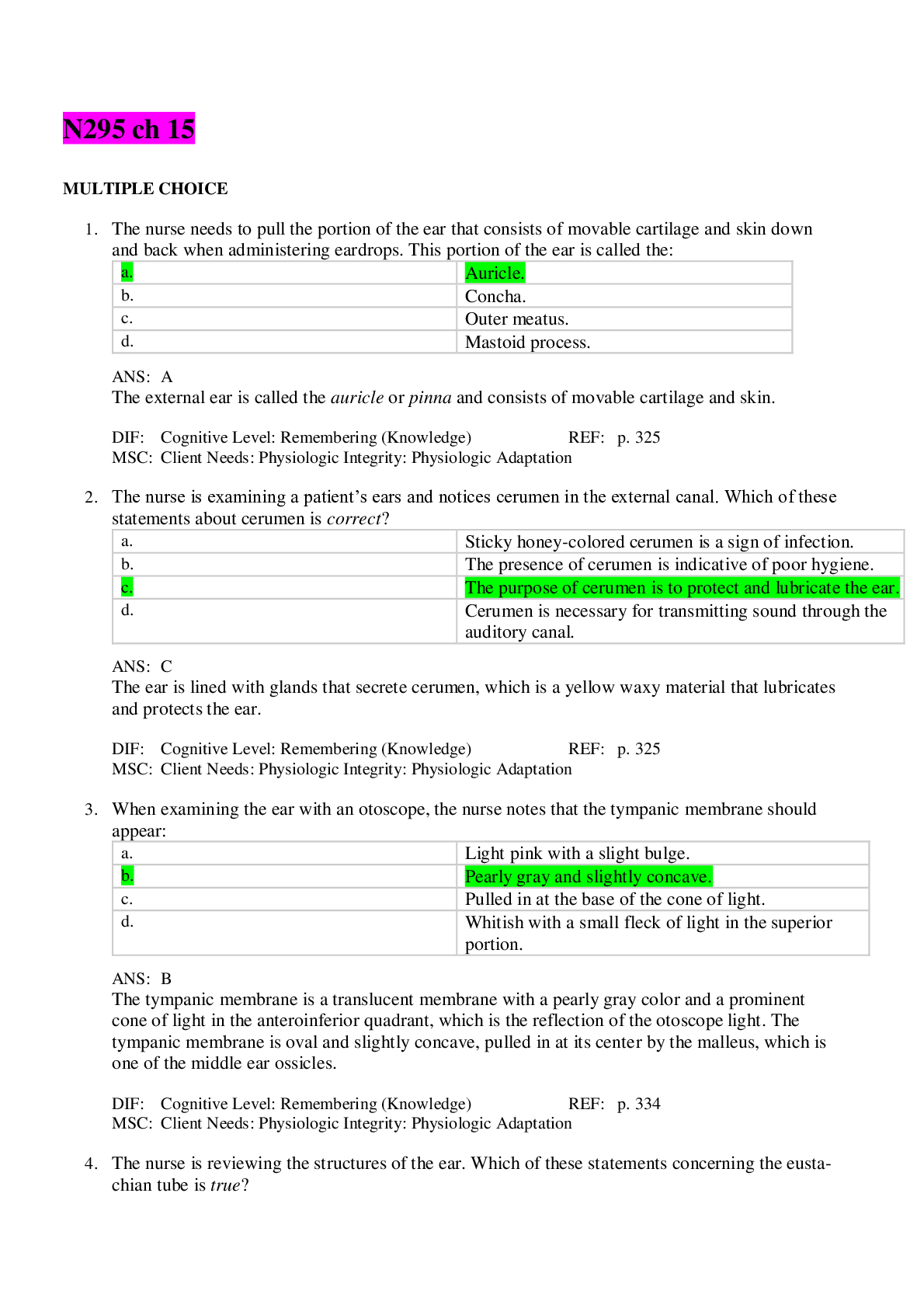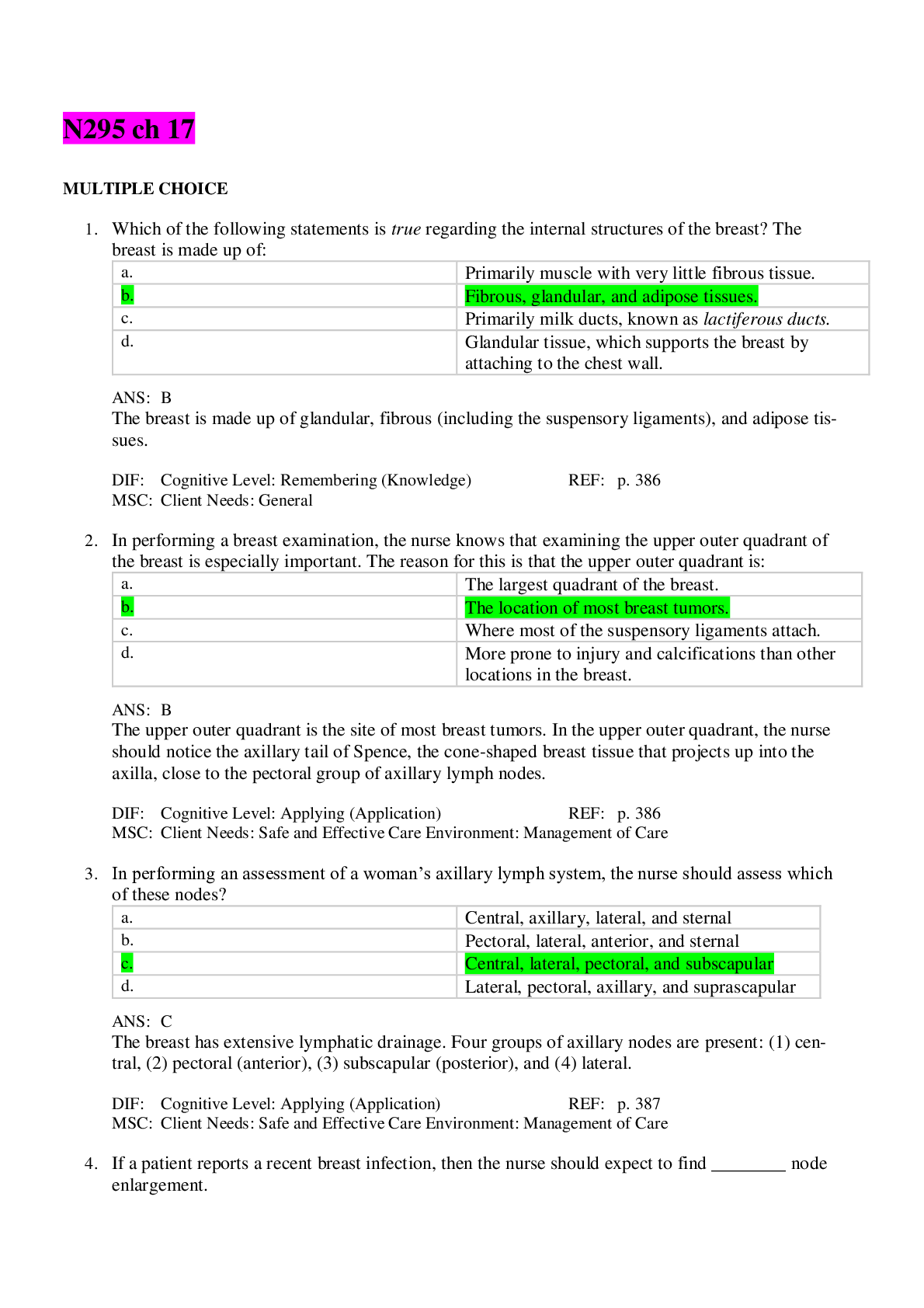c5 CNURSING 295 - Questions & Answers, Rated A
Document Content and Description Below
N295 ch5 MULTIPLE CHOICE 1. During an examination, the nurse can assess mental status by which activity? 2. The nurse is assessing the mental status of a child. Which statement about chil... dren and mental status is true? 3. The nurse is assessing a 75-year-old man. As the nurse begins the mental status portion of the assessment, the nurse expects that this patient: 4. When assessing aging adults, the nurse knows that one of the first things that should be assessed before making judgments about their mental status is: 5. The nurse is preparing to conduct a mental status examination. Which statement is true regarding the mental status examination? 6. A woman brings her husband to the clinic for an examination. She is particularly worried because after a recent fall, he seems to have lost a great deal of his memory of recent events. Which statement reflects the nurse’s best course of action? 7. The nurse is conducting a patient interview. Which statement made by the patient should the nurse more fully explore during the interview? 8. A patient is admitted to the unit after an automobile accident. The nurse begins the mental status examination and finds that the patient has dysarthric speech and is lethargic. The nurse’s best ap-proach regarding this examination is to: 9. A 19-year-old woman comes to the clinic at the insistence of her brother. She is wearing black combat boots and a black lace nightgown over the top of her other clothes. Her hair is dyed pink with black streaks throughout. She has several pierced holes in her nares and ears and is wearing an earring through her eyebrow and heavy black makeup. The nurse concludes that: 10. A patient has been in the intensive care unit for 10 days. He has just been moved to the medical-surgical unit, and the admitting nurse is planning to perform a mental status examination. During the tests of cognitive function, the nurse would expect that he: 11. During a mental status examination, the nurse wants to assess a patient’s affect. The nurse should ask the patient which question? 12. The nurse is planning to assess new memory with a patient. The best way for the nurse to do this would be to: 13. A 45-year-old woman is at the clinic for a mental status assessment. In giving her the Four Unrelated Words Test, the nurse would be concerned if she could not ____ four unrelated words ____. 14. During a mental status assessment, which question by the nurse would best assess a person’s judgment? 15. Which of these individuals would the nurse consider at highest risk for a suicide attempt? 16. The nurse is performing a mental status assessment on a 5-year-old girl. Her parents are undergoing a bitter divorce and are worried about the effect it is having on their daughter. Which action or statement might lead the nurse to be concerned about the girl’s mental status? 17. The nurse is assessing orientation in a 79-year-old patient. Which of these responses would lead the nurse to conclude that this patient is oriented? 18. The nurse is performing the Denver II screening test on a 12-month-old infant during a routine well-child visit. The nurse should tell the infant’s parents that the Denver II: 19. A patient drifts off to sleep when she is not being stimulated. The nurse can easily arouse her by calling her name, but the patient remains drowsy during the conversation. The best description of this patient’s level of consciousness would be: 20. A patient has had a cerebrovascular accident (stroke). He is trying very hard to communicate. He seems driven to speak and says, “I buy obie get spirding and take my train.” What is the best de-scription of this patient’s problem? 21. A patient repeatedly seems to have difficulty coming up with a word. He says, “I was on my way to work, and when I got there, the thing that you step into that goes up in the air was so full that I decided to take the stairs.” The nurse will note on his chart that he is using or experiencing: 22. During an examination, the nurse notes that a patient is exhibiting flight of ideas. Which statement by the patient is an example of flight of ideas? 23. A patient describes feeling an unreasonable, irrational fear of snakes. His fear is so persistent that he can no longer comfortably look at even pictures of snakes and has made an effort to identify all the places he might encounter a snake and avoids them. The nurse recognizes that he: 24. A patient has been diagnosed with schizophrenia. During a recent interview, he shows the nurse a picture of a man holding a decapitated head. He describes this picture as horrifying but then laughs loudly at the content. This behavior is a display of: 25. During reporting, the nurse hears that a patient is experiencing hallucinations. Which is an example of a hallucination? 26. A 20-year-old construction worker has been brought into the emergency department with heat stroke. He has delirium as a result of a fluid and electrolyte imbalance. For the mental status ex-amination, the nurse should first assess the patient’s: 27. A patient states, “I feel so sad all of the time. I can’t feel happy even doing things I used to like to do.” He also states that he is tired, sleeps poorly, and has no energy. To differentiate between a dysthymic disorder and a major depressive disorder, the nurse should ask which question? 28. A 26-year-old woman was robbed and beaten a month ago. She is returning to the clinic today for a follow-up assessment. The nurse will want to ask her which one of these questions? 29. The nurse is performing a mental status examination. Which statement is true regarding the assessment of mental status? 30. A 23-year-old patient in the clinic appears anxious. Her speech is rapid, and she is fidgety and in constant motion. Which of these questions or statements would be most appropriate for the nurse to use in this situation to assess attention span? 31. The nurse is planning health teaching for a 65-year-old woman who has had a cerebrovascular accident (stroke) and has aphasia. Which of these questions is most important to use when as-sessing mental status in this patient? 32. A 30-year-old female patient is describing feelings of hopelessness and depression. She has attempted self-mutilation and has a history of suicide attempts. She describes difficulty sleeping at night and has lost 10 pounds in the past month. Which of these statements or questions is the nurse’s best response in this situation? 33. The nurse is providing instructions to newly hired graduates for the mini–mental state examina-tion (MMSE). Which statement best describes this examination? 34. The nurse discovers speech problems in a patient during an assessment. The patient has sponta-neous speech, but it is mostly absent or is reduced to a few stereotypical words or sounds. This finding reflects which type of aphasia? 35. A patient repeats, “I feel hot. Hot, cot, rot, tot, got. I’m a spot.” The nurse documents this as an illustration of: 36. During an interview, the nurse notes that the patient gets up several times to wash her hands even though they are not dirty. This behavior is an example of: 37. The nurse is administering a Mini-Cog test to an older adult woman. When asked to draw a clock showing the time of 10:45, the patient drew a clock with the numbers out of order and with an incorrect time. This result indicates which finding? 38. During morning rounds, the nurse asks a patient, “How are you today?” The patient responds, “You today, you today, you today!” and mumbles the words. This speech pattern is an example of: MULTIPLE RESPONSE 1. The nurse is assessing a patient who is admitted with possible delirium. Which of these are manifestations of delirium? Select all that apply. [Show More]
Last updated: 1 year ago
Preview 1 out of 15 pages
Instant download
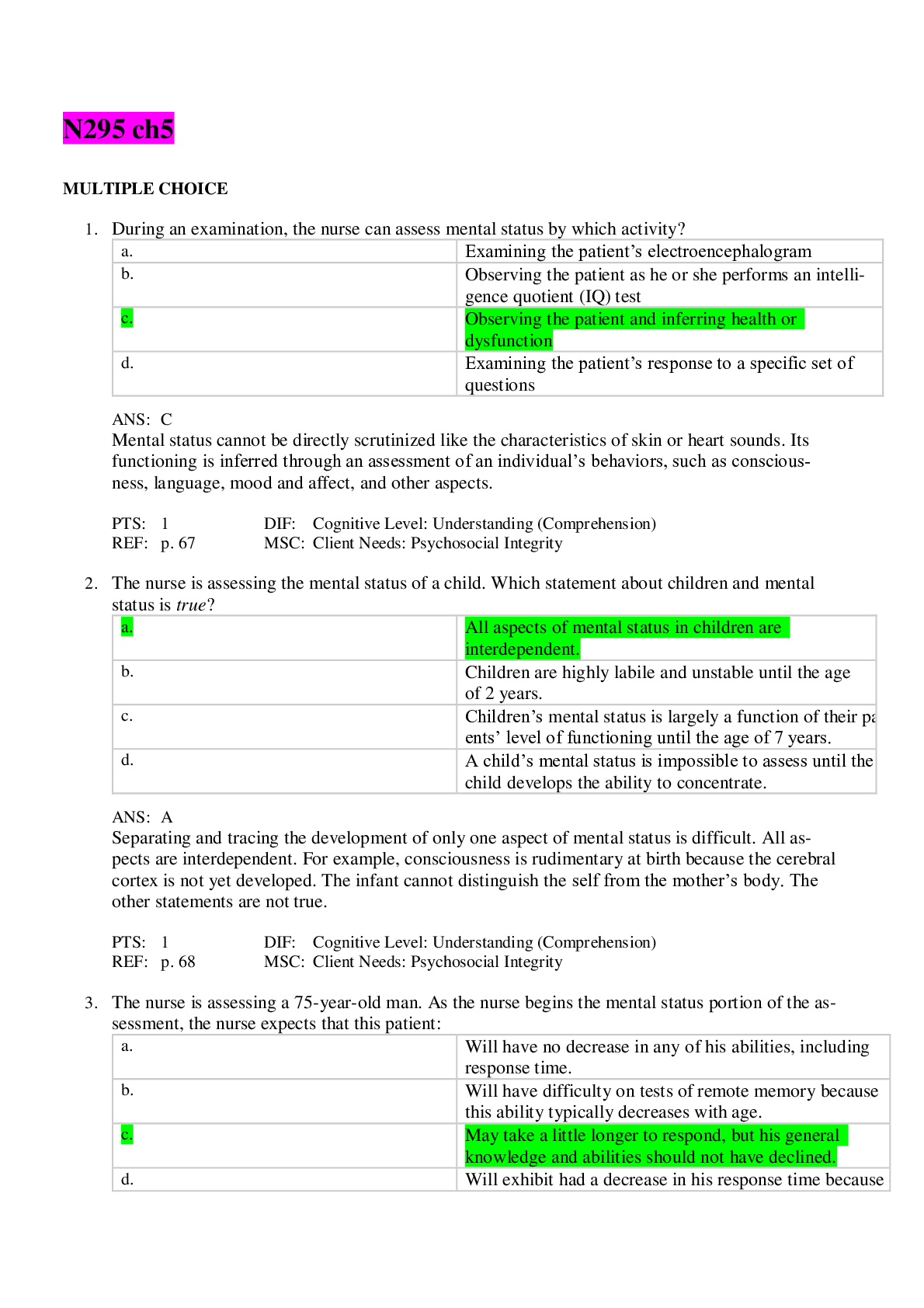
Buy this document to get the full access instantly
Instant Download Access after purchase
Add to cartInstant download
Also available in bundle (1)

CNURSING 295
CHAPTER 23 NEUROLOGIC SYSTEM,CHAPTER 21 ABDOMINAL ASSESSMENT,N295 EXAM 4,N295 EXAM 3,c22,c21,c19,c18,c17,c16,c15,c14,c13,c12,c11,c10,c9,c8,c7,c6,c5,c4,c2,c1
By Ajay25 3 years ago
$75
24
Reviews( 0 )
Document information
Connected school, study & course
About the document
Uploaded On
Jan 14, 2021
Number of pages
15
Written in
Additional information
This document has been written for:
Uploaded
Jan 14, 2021
Downloads
0
Views
54


